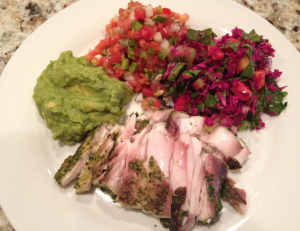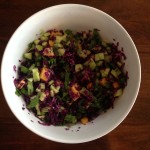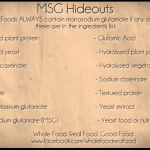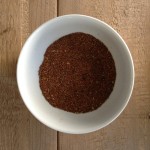My grocery store had wild-caught mahi mahi this week, so I decided to pick some up and try a recipe from Alton Brown. I modified this recipe a bit and we did not use the fish for tacos, we just ate it by itself. It is so full of flavor, it doesn’t need much to go with it. I was in a time crunch the evening that I made this dinner, so I took a shortcut and used store-bought organic guacamole and store-bought organic salsa. The guacamole we used is from Wholly Guacamole, the only ingredients are: Organic Avocados, Organic Dehydrated Onions, Organic White Vinegar, Salt and Organic Granulated Garlic. I had made a slaw in the morning for the side and it was the perfect accompaniment to the dish. Crisp, fresh and full of flavor to compliment the fish. The recipe for the slaw comes from the Paleo Comfort Foods book by Julie & Charles Mayfield. You can also make the slaw the night before to create a quicker dinner the next night.
I was excited to find wild-caught fish because it is a much better choice than farm-raised fish. Wild-caught fish eat kelp, algae, seaweed, fish, and other organisms in their natural environment that their bodies can easily metabolize. The diets of farmed fish typically include genetically modified monocrops such as soy, corn, and canola that are not found in their natural environment and are typically nutrient-poor compared to their natural diet. Since wild-caught fish eat a more varied and natural diet, they tend to be higher in most vitamins and minerals than farmed fish. (Source)
Eating mahi mahi benefits your health by contributing to your daily protein intake. Each 3-ounce serving of the fish provides 20.2 grams of protein, which your body uses to maintain your tissues. Mahi mahi is a source of complete protein, which means it contains all the essential amino acids you need to survive. Eat mahi mahi on a regular basis to help you reach your target protein intake — 0.4 grams per pound of body weight, according to the Iowa State University Extension. A 3-ounce portion provides approximately one-third of the recommended daily protein intake for a 150-pound individual.
Mahi mahi also serves as a source of essential vitamins. The fish contains several B vitamins, including thiamin, riboflavin and vitamin B-6. It provides a particularly rich source of niacin, or vitamin B-3 — each 3-ounce serving contains 45 percent of the recommended daily intake for women, or 39 percent for men, according to the Linus Pauling Institute. Your body needs B vitamins to support your metabolism, and these nutrients also help nourish your skin and liver.
Adding mahi mahi to your diet helps increase your iron intake. Iron helps your red blood cells carry oxygen throughout your body, so your tissues have a steady supply of fresh oxygen to support their day-to-day functioning. Mahi mahi contains heme iron, a form of iron readily absorbed by your body. A 3-ounce serving of mahi mahi provides 1.2 milligrams, which is 15 percent of the daily requirement for men and approximately 7 percent for women, according to the Office of Dietary Supplements. (Source)
Cilantro Lime Mahi Mahi
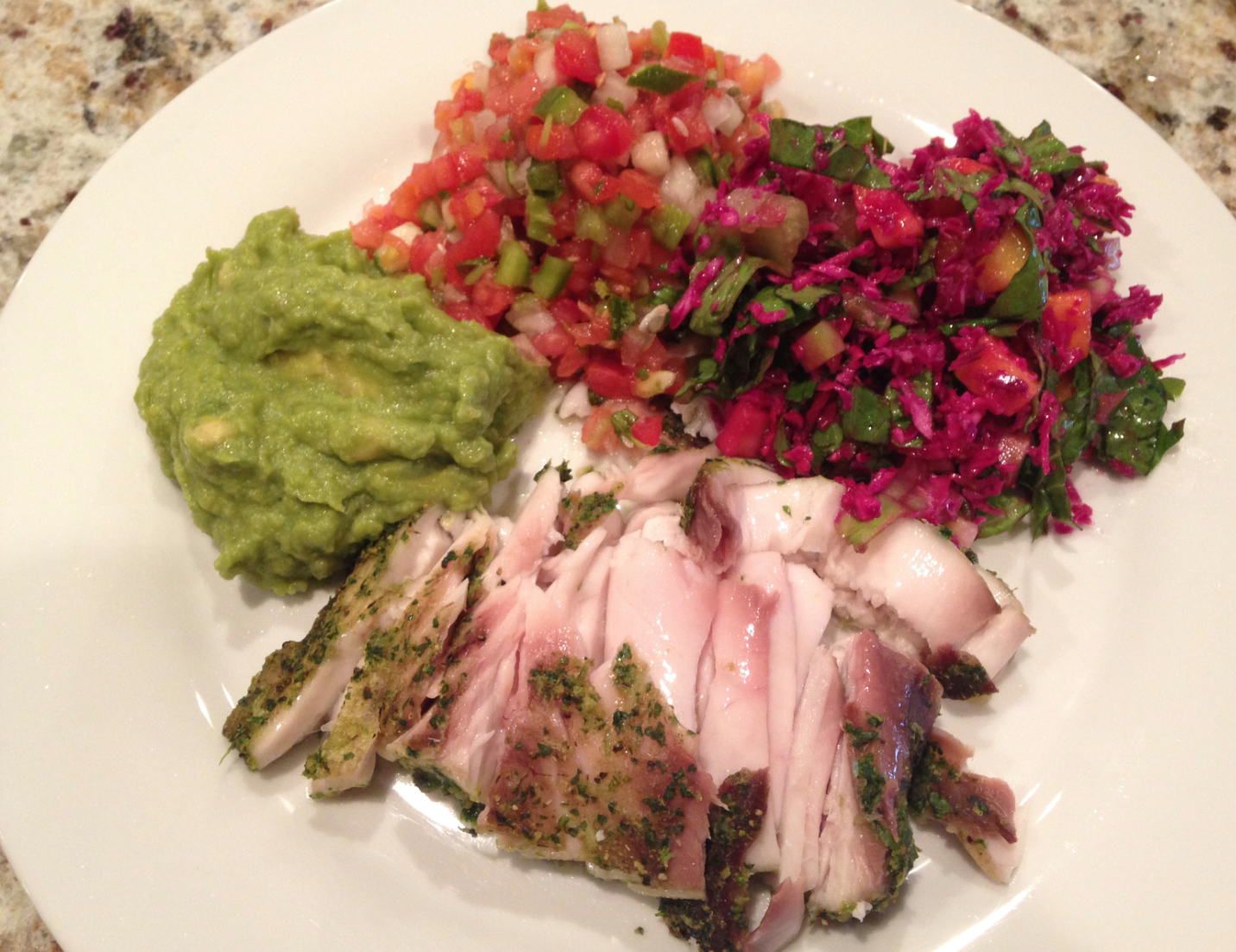
Whole Food. Real Food. Good Food.
Ingredients
- 3 cloves garlic
- 1 cup packed cilantro leaves
- 2 limes, zested
- 2 teaspoons ground cumin
- 1 1/2 teaspoons Himalayan Pink Salt
- 1 teaspoon freshly ground black pepper
- 1/4 cup tequila
- 1-2 pounds mahi mahi (tilapia or grouper will work too)
- 1 tablespoon olive oil
- Lime wedges
Instructions
- Pre-heat oven to 375 degrees.
- Put the garlic, cilantro, lime zest, cumin, salt, and pepper in a small food processor bowl and pulse until combined, approximately 20 seconds.
- With the processor running, add the tequila.
- Put the tilapia fillets into a 1 gallon resealable bag, add the garlic mixture and move around to coat each fillet.
- Set aside at room temperature for 15 to 20 minutes.
- Brush baking sheet with olive oil.
- Bake for 10-12 minutes until the fillets are just cooked through and opaque.
- Cut into strips and serve with salsa, guacamole, slaw and lime wedges.
- Enjoy!
Cilantro Lime Mahi Mahi
3 cloves garlic
1 cup packed cilantro leaves
2 limes, zested
2 teaspoons ground cumin
1 1/2 teaspoons Himalayan Pink Salt
1 teaspoon freshly ground black pepper
1/4 cup tequila
1-2 pounds mahi mahi (tilapia or grouper will work too)
1 tablespoon olive oil
Lime wedges
1. Pre-heat oven to 375 degrees.
2. Put the garlic, cilantro, lime zest, cumin, salt, and pepper in a small food processor bowl and pulse until combined, approximately 20 seconds.
3. With the processor running, add the tequila.
4. Put the tilapia fillets into a 1 gallon resealable bag, add the garlic mixture and move around to coat each fillet.
5. Set aside at room temperature for 15 to 20 minutes.
6. Brush baking sheet with olive oil.
7. Bake for 10-12 minutes until the fillets are just cooked through and opaque.
8. Cut into strips and serve with salsa, guacamole, slaw and lime wedges.
9. Enjoy!
To receive daily health tips and gluten-free, grain-free, dairy-free and sugar-free meal/snack ideas, like us at www.facebook.com/wholefoodrealfood.
– Eat Better. Feel Better.


